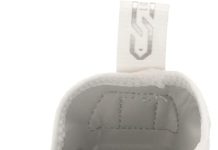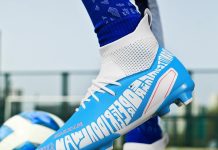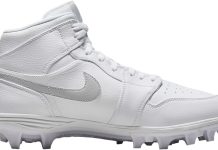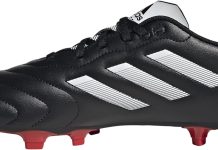We are looking for a pair of cleats that can withstand the test of time. Look no further! Our article, “Are Metal or Plastic Cleats More Durable?” explores the age-old debate between metal and plastic cleats to determine which material reigns supreme regarding durability.
Whether you’re a soccer star, a baseball enthusiast, or simply curious about the science behind sports equipment, join us as we unravel the secrets of these two cleat materials and uncover which one truly stands the test of time.
Benefits of Metal Cleats
Review contents
Stability and Traction
One of the most significant advantages of using metal cleats is their enhanced stability and traction. The metal spikes on the soles of the cleats dig deep into the ground, allowing for a secure grip even on wet or slippery surfaces. This gives athletes confidence and stability, which is crucial for performance on the field. Whether sprinting, making quick cuts, or stopping abruptly, metal cleats offer excellent traction, minimizing the risk of slipping or losing balance.
Durability
Metal cleats are known for their exceptional durability. The metal spikes are sturdy and withstand rigorous use and harsh playing conditions. Whether playing on natural grass or rugged terrain, metal cleats are designed to handle the wear and tear. They can last longer than plastic cleats, mainly when used by athletes who play frequently or participate in high-intensity sports.
Enhanced Performance
With the stability, traction, and durability that metal cleats offer, athletes often experience enhanced performance on the field. The secure grip allows for explosive movements, quick acceleration, and precise changes in direction. The ability to trust your footing can significantly impact your performance, giving you the confidence to push harder and reach your full potential. Metal cleats can provide the edge you need to excel in competitive sports.
Drawbacks of Metal Cleats
Price
One of the main drawbacks of metal cleats is their higher price than plastic cleats. The metal spikes and the materials used in their construction make them more expensive to produce. This cost is often passed on to the consumer, producing higher price points for metal cleats. This can be a deterrent for some athletes, especially those on a budget or participating in amateur leagues.
Field Restrictions
Another drawback of metal cleats is their restrictions on their use in specific playing fields. Some sports associations, leagues, or specific venues may prohibit the use of metal cleats due to concerns about damage to the playing surface. Metal spikes can dig deeper into the ground and potentially cause more harm to the grass or turf. As a result, athletes may have to switch to plastic cleats or choose different venues that allow metal cleats. This limitation can restrict the options available to athletes who prefer metal cleats.
Benefits of Plastic Cleats
Affordability
One of the significant advantages of plastic cleats is their affordability. Plastic cleats are generally less expensive than their metal counterparts, making them more accessible to a broader range of athletes. This affordability factor is particularly beneficial for beginners, youth sports teams, or individuals on a tight budget who may not want to invest heavily in their sports gear.
Versatility
Plastic cleats offer versatility in terms of where they can be used. While metal cleats may be restricted to specific playing fields, plastic cleats are usually allowed in most sports venues, including artificial turf and grass surfaces. This versatility allows athletes to use plastic cleats across various settings without worrying about violating regulations or damaging the playing surface.
Comfort
One of the key benefits of plastic cleats is the comfort they provide. The materials used in their construction, such as lightweight synthetics and cushioned insoles, offer a more comfortable fit. Plastic cleats often have additional cushioning or padding, which can help reduce the risk of foot fatigue, blisters, or discomfort during long hours of play. The flexibility of plastic cleats also allows for better foot movement, offering a more natural and comfortable experience on the field.
Drawbacks of Plastic Cleats
Less Traction
While plastic cleats do offer decent traction, they generally have less grip than metal cleats. The plastic studs on the sole may not penetrate the ground as deeply as metal spikes, resulting in a slightly reduced level of traction. This can be especially noticeable on wet or slippery surfaces, where athletes might experience a slight decrease in stability and grip compared to metal cleats. However, this reduced traction may not significantly impact performance for sports played on artificial turf or well-maintained grass fields.
Less Durability
Plastic cleats tend to be less durable compared to their metal counterparts. The materials used in their construction, such as plastics and synthetic compounds, are not as resistant to wear and tear. Over time, the studs on plastic cleats may wear down or break, resulting in diminished performance and a need for replacement. Athletes who frequently engage in high-impact sports or play on rough surfaces may find that plastic cleats must be replaced more often, increasing long-term costs.
Comparison of Durability
Material Composition
Their material composition can influence the durability of cleats. Metal cleats are typically made of solid metals like steel or aluminum, offering excellent resistance to bending or breaking. The metal spikes are secured firmly to the sole, providing additional reinforcement. On the other hand, plastic cleats are constructed using various types of plastics and synthetic materials. While these materials are lightweight and flexible, they can be more prone to wear and tear, reducing durability compared to metal cleats.
Construction Design
Apart from material composition, the construction design of the cleats also plays a role in their durability. Metal cleats often have a more robust and rugged design, focusing on reinforced stitching, additional support structures in the sole, and secure attachment of the metal spikes. These features contribute to the overall durability and longevity of metal cleats. Although lighter and more flexible, plastic cleats may have less reinforcement in the sole and fewer support structures, which can impact their durability.
Material Composition
Metal Cleats
Metal cleats are typically made of solid and durable steel or aluminum. These metals are chosen for their strength, resistance to bending or breaking, and ability to withstand various playing conditions. The metal spikes are securely attached to the sole, ensuring they stay in place during intense movements. This combination of robust materials and secure construction gives metal cleats their reputation for durability.
Plastic Cleats
Plastic cleats are constructed using various types of plastics and synthetic compounds. These materials are lightweight, flexible, and often provide good durability. However, plastic cleats are generally not as resilient as metal cleats when it comes to resisting wear and tear. The studs on plastic cleats can wear down or break more quickly, especially when exposed to rough playing surfaces or frequent use.
Construction Design
Metal Cleats
Metal cleats are designed with durability in mind. The construction of metal cleats often includes reinforced stitching, additional support structures in the sole, and secure attachment of the metal spikes. These design elements ensure that the cleats can withstand the demands of high-intensity sports and rough playing surfaces. Metal cleats are built to last, even under challenging conditions.
Plastic Cleats
Plastic cleats generally have a lighter and more flexible construction design. They may have fewer support structures and reinforcement in the sole compared to metal cleats. While this design allows for better flexibility and a more comfortable fit, it can decrease durability. Plastic cleats’ lighter materials and construction design make them more susceptible to wear and tear, especially when subjected to rigorous use or rough playing conditions.
Factors Affecting Durability
Field Conditions
The playing field conditions can significantly influence the durability of metal and plastic cleats. Different field surfaces, such as grass or artificial turf, can have varying effects on the lifespan of the cleats. For example, playing on well-maintained natural grass fields generally impacts cleat durability less than playing on rugged or poorly maintained surfaces. Similarly, artificial turf fields can be harsh on metal and plastic cleats, potentially resulting in faster wear and tear.
Playing Style
The playing style of athletes can also impact the durability of cleats. Aggressive play, involving frequent changes in direction, sudden stops, and high-impact movements, can stress the cleats more. These movements can wear down the studs or strain the attachment mechanisms, reducing the overall lifespan of the cleats. On the other hand, a more conservative playing style with fewer dynamic movements may result in less wear and tear, increasing the durability of the cleats.
Maintenance
Proper maintenance and care of cleats can also affect their durability. Regular cleaning and drying after each use and storage in a suitable environment can help prolong the lifespan of both metal and plastic cleats. Replacing worn or damaged studs or spikes can prevent further wear on the sole. Neglecting maintenance tasks can contribute to accelerated deterioration and decreased durability of the cleats.
Field Conditions
Grass Surface
Playing on natural grass surfaces puts less strain on cleats than on rough or poorly maintained surfaces. Natural grass tends to provide a more forgiving playing surface, reducing the impact on the cleat studs. However, grass fields that are not well-maintained or have uneven terrain can still contribute to wear and tear. It is essential to consider the field conditions and the frequency of use when assessing the durability of cleats used on grass surfaces.
Artificial Turf
Artificial turf fields can be more demanding on cleats, regardless of their composition. The synthetic surface material can be abrasive, causing faster wear and tear on metal and plastic cleats. Additionally, the repetitive movements on artificial turf can contribute to the degradation of the cleat studs over time. When playing on artificial turf, it is essential to choose cleats that have adequate durability and perform regular maintenance to maximize their lifespan.
Playing Style
Aggressive Play
Athletes with an aggressive playing style, characterized by frequent changes in direction, sudden stops, and explosive movements, put additional stress on their cleats. These high-impact movements can lead to faster wear and tear, regardless of the material composition of the cleats. Metal cleats can provide better durability and resistance to the demands of aggressive play, but proper maintenance and regular replacement of worn-down studs are essential to maximize their lifespan.
Conservative Play
A more conservative playing style, with fewer dynamic movements and less stress on the cleats, can contribute to increased durability. Athletes who engage in conservative play may find that metal and plastic cleats last longer than those with an aggressive playing style. However, it is still essential to consider the field conditions and maintenance to ensure optimal durability and performance.
In conclusion, the durability of cleats is influenced by various factors, including the material composition, construction design, field conditions, playing style, and maintenance.
Metal cleats offer superior stability, traction, and durability, making them an excellent choice for athletes who prioritize these qualities. However, they come at a higher price and may be restricted in specific fields.
Plastic cleats offer affordability, versatility, and comfort but may have reduced traction and durability compared to metal cleats. Ultimately, the choice between metal and plastic cleats depends on individual preferences, playing conditions, and the desired level of durability for each athlete.





































